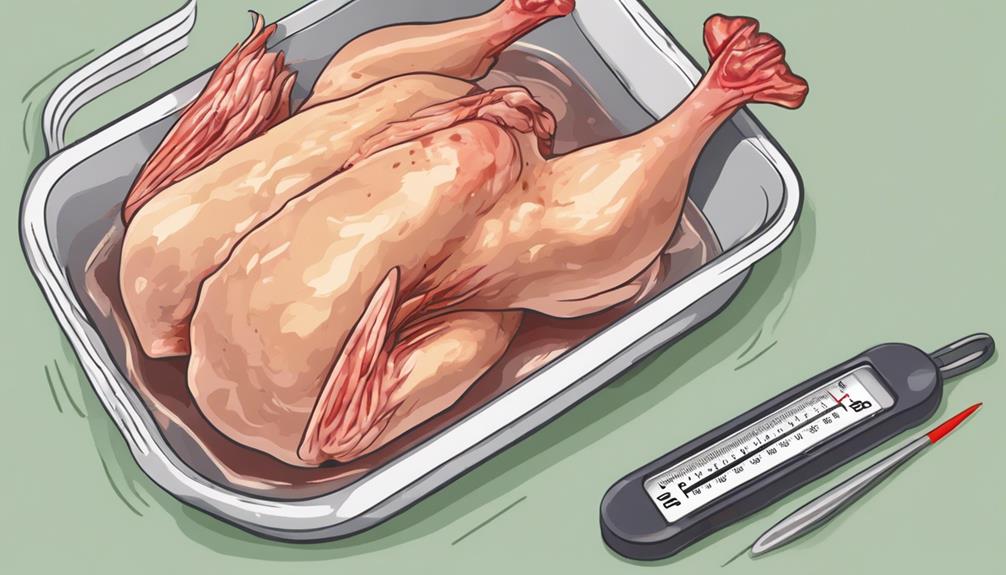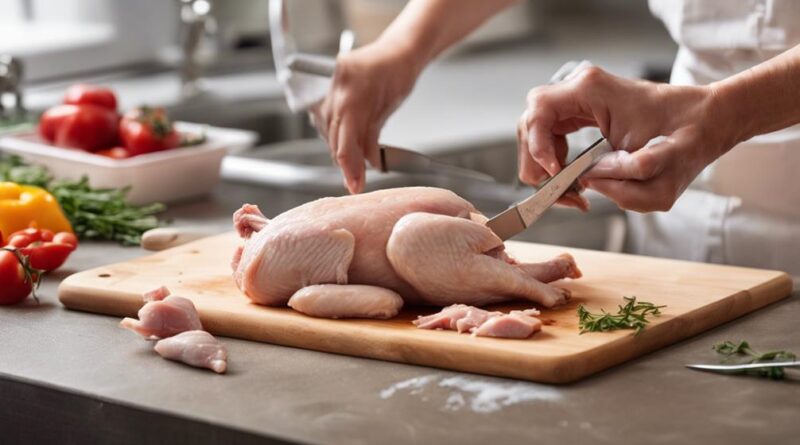What Are Essential Chicken Food Safety Measures?"
To ensure chicken safety, wash hands before and after handling. Use separate tools for raw chicken. Marinate in the fridge and cook to 165°F. Prevent cross-contamination by storing properly and thawing correctly. Check expiration dates and store chicken below 40°F. Watch for spoilage signs like odd smells or textures. Hygiene matters—wash hands and sanitize often. Consider these essential measures to safeguard your health and loved ones'.
Proper Chicken Handling Techniques
When handling chicken, always remember to wash your hands thoroughly before and after any contact with raw poultry. Proper hand washing is crucial in food preparation to prevent the spread of harmful bacteria. Before beginning any chicken-related tasks, ensure your hands are clean by using soap and warm water, scrubbing for at least 20 seconds, and drying them with a clean towel.
During food preparation, it's essential to keep raw chicken separate from other ingredients to avoid cross-contamination. Use different cutting boards, utensils, and containers for raw chicken to prevent the spread of bacteria to ready-to-eat foods. After cutting or handling raw chicken, wash all surfaces, utensils, and hands with hot, soapy water.
When marinating chicken, always do so in the refrigerator to keep it at a safe temperature and prevent bacterial growth. Discard any leftover marinade that has come into contact with raw chicken to avoid foodborne illnesses. It's also important to cook chicken thoroughly to kill any harmful bacteria that may be present. Use a food thermometer to ensure that chicken reaches a safe internal temperature of 165°F (74°C).
Importance of Cooking Temperatures
Maintain precision and ensure food safety by understanding the significance of cooking temperatures when preparing chicken dishes. Temperature control is crucial to kill harmful bacteria present in chicken. The USDA recommends cooking chicken to an internal temperature of 165°F (73.9°C) to ensure it's safe to eat. Using a food thermometer is the most accurate way to check if chicken is cooked to the proper temperature. Insert the thermometer into the thickest part of the meat without touching bone, and wait for a few seconds for an accurate reading.
Following cooking guidelines is essential to prevent foodborne illnesses. When roasting a whole chicken, it's important to preheat the oven to at least 325°F (162.8°C) and cook the chicken until it reaches the safe internal temperature. For chicken pieces, such as breasts or thighs, ensure they reach 165°F (73.9°C) as well.
Grilling chicken is a popular method, but make sure the grill reaches a temperature of 165°F (73.9°C) and use a meat thermometer to verify doneness.
Avoiding Cross-Contamination Risks
To ensure chicken food safety, meticulously separate raw chicken from other foods during preparation to avoid cross-contamination risks. Cross contamination prevention is crucial in maintaining food safety standards. When handling raw chicken, use separate cutting boards, utensils, and containers to prevent bacteria from spreading to other foods. Wash your hands thoroughly with soap and water after handling raw chicken to avoid transferring any bacteria.
In addition to proper handling techniques, food storage safety is essential to prevent cross-contamination. Store raw chicken in airtight containers or sealed plastic bags on the bottom shelf of the refrigerator to prevent any drips or leaks from contaminating other foods. Make sure to label the containers with the date of purchase to ensure you use the chicken within a safe timeframe.
When thawing frozen chicken, do so in the refrigerator or under cold water to prevent bacteria growth. Avoid thawing chicken on the counter at room temperature, as this can lead to rapid bacterial multiplication. By following these food storage safety practices, you can significantly reduce the risk of cross-contamination and ensure the safety of your chicken dishes.
Understanding Expiration Dates
Understanding expiration dates on chicken packaging is crucial for ensuring food safety and quality. When it comes to food storage, always check the expiration date on the chicken packaging before purchase. This date indicates the last day the product is guaranteed to be at its best quality. It's important to understand that expiration dates are based on the manufacturer's testing and are reliable indicators of freshness.
Label reading is a skill that every consumer should master. The expiration date on chicken packaging is typically labeled as 'Best By,' 'Sell By,' or 'Use By.' 'Best By' indicates the date until which the product is expected to be at its peak quality, while 'Sell By' is for the retailer to know when to remove the product from shelves. 'Use By' is the date recommended for the consumer to use the product by for the best quality.
To ensure food safety, always adhere to these guidelines and consume chicken before the expiration date. Proper food storage is also essential in maintaining the quality and safety of chicken products. Follow storage instructions on the packaging, refrigerate promptly, and never leave chicken at room temperature for an extended period. By understanding expiration dates and practicing proper food storage, you can safeguard your health and enjoy high-quality chicken products.
Cleaning and Sanitizing Practices
Implement thorough cleaning and sanitizing practices to ensure a hygienic environment for handling chicken products. Proper maintenance of equipment used in the preparation of chicken dishes is crucial for preventing cross-contamination and ensuring food safety. Regularly clean and sanitize all surfaces and tools that come in contact with raw chicken, including cutting boards, knives, and countertops. Use hot, soapy water to wash these items after each use, and sanitize them with a solution of bleach and water.
In addition to equipment maintenance, proper food storage is essential for preventing bacterial growth and contamination. Store raw chicken in airtight containers on the bottom shelf of the refrigerator to prevent juices from dripping onto other foods. Ensure that the refrigerator is set to the appropriate temperature to keep chicken and other perishable items fresh.
Maintaining kitchen organization is key to minimizing the risk of foodborne illnesses. Keep raw chicken separate from ready-to-eat foods to prevent cross-contamination. Use different cutting boards and utensils for raw and cooked chicken to avoid spreading harmful bacteria. Regularly sanitize surfaces, handles, and knobs in the kitchen to eliminate any potential pathogens.
Safe Storage of Chicken Products
Proper storage of chicken products is crucial to maintaining their freshness and preventing foodborne illnesses. When it comes to safe storage, temperature control is paramount. Raw chicken should always be stored at a temperature below 40°F (4°C) to inhibit the growth of harmful bacteria. It's recommended to use a refrigerator thermometer to ensure the temperature stays within the safe range.
Additionally, packaging integrity plays a significant role in preserving the quality of chicken products. Make sure to check the packaging for any damage or leaks before storing it in the refrigerator or freezer. If the original packaging is compromised, transfer the chicken to an airtight container or a resealable plastic bag to prevent cross-contamination and freezer burn.
For refrigerated storage, place raw chicken on the bottom shelf to prevent any drips from contaminating other foods. Keep it separate from ready-to-eat items to avoid any potential cross-contamination. When freezing chicken, ensure it's tightly sealed to maintain its texture and taste.
Recognizing Signs of Spoilage

To identify signs of spoilage in chicken products, closely examine the appearance and smell of the meat. When it comes to identifying off odors, spoiled chicken will emit a strong, unpleasant smell that's different from the usual chicken odor. If you notice a foul or ammonia-like scent, it's best to discard the chicken. Another indicator of spoilage is a slimy texture on the surface of the meat. Fresh chicken should feel moist but not slimy to the touch. If you encounter a slimy film, it's a sign that the chicken has gone bad.
Discoloration is also a key indicator of spoilage. Fresh chicken meat typically has a pink color, so any gray, green, or yellow discoloration is a cause for concern. Additionally, abnormal textures such as excessive stickiness or a mushy consistency are signs of deterioration.
Proper storage techniques, such as keeping chicken refrigerated at 40°F or below, can help prevent spoilage. Safe defrosting methods, like thawing chicken in the refrigerator or using the defrost setting on a microwave, are essential to maintain the quality and safety of the meat. By being attentive to these signs and following recommended practices, you can ensure that the chicken you consume is safe and free from spoilage.
Implementing Personal Hygiene Practices
Maintaining good personal hygiene practices is crucial when handling chicken to prevent contamination and ensure food safety. Proper handwashing techniques are essential to reduce the risk of spreading harmful bacteria. Before and after handling raw chicken, scrub your hands with soap and water for at least 20 seconds. This simple yet effective practice significantly decreases the likelihood of foodborne illnesses.
In addition to handwashing, proper glove usage is another key aspect of personal hygiene when dealing with chicken. When preparing or touching raw chicken, always wear disposable gloves to prevent cross-contamination. Remember to change gloves between tasks and wash your hands thoroughly after removing them.
Sanitation methods play a vital role in maintaining a hygienic environment during food preparation. Clean and disinfect all surfaces and utensils that come in contact with raw chicken. Use hot, soapy water to wash cutting boards, knives, and countertops to eliminate any lingering bacteria.
Frequently Asked Questions
How Can I Safely Defrost Chicken?
To safely defrost chicken, it's important to use proper thawing methods. Avoid leaving it out at room temperature to prevent bacteria growth. Thaw in the refrigerator, under cold water, or in the microwave.
Be cautious about cross-contamination by keeping the chicken separate from other foods. By handling chicken safely during defrosting, you reduce the risk of foodborne illnesses. Remember these steps for a healthier meal prep process.
Can I Reuse Marinades From Raw Chicken?
When it comes to reusing marinades from raw chicken, it's best to avoid it due to marinade safety concerns and the risk of cross-contamination. Using fresh marinades each time ensures proper marinating techniques and helps retain the flavors without compromising food safety.
To prevent any health risks, it's recommended to discard any marinade that has come into contact with raw chicken to maintain a safe and enjoyable cooking experience.
Is It Safe to Eat Chicken Left Out Overnight?
Leaving chicken out overnight poses food poisoning risks due to bacterial growth. Bacteria multiply rapidly at room temperature, increasing the chances of contamination.
To prevent illness, always refrigerate chicken promptly. If chicken has been left out for more than 2 hours, discard it to avoid potential foodborne illnesses.
What Is the Best Way to Store Leftover Cooked Chicken?
When storing leftover cooked chicken, it's crucial to prioritize food safety. Proper refrigeration is key.
After enjoying your meal, promptly transfer the chicken into airtight containers and store them in the refrigerator within two hours. Make sure the temperature is below 40°F (4°C).
When reheating, ensure the chicken reaches an internal temperature of 165°F (74°C) to kill any potential bacteria.
How Often Should I Clean My Cutting Board Used for Chicken?
To prevent cross-contamination, clean your cutting board used for chicken after each use. Cleaning frequency is crucial to avoid spreading harmful bacteria.
Use hot, soapy water to scrub the board thoroughly, and consider using a separate board for raw chicken to minimize risks.
Conclusion
In conclusion, practicing proper chicken food safety measures is essential to prevent foodborne illnesses. By following guidelines for handling, cooking, and storing chicken products, you can reduce the risk of contamination and ensure the safety of your meals.
Remember to always maintain good hygiene practices and pay attention to expiration dates to keep your chicken dishes safe and delicious. Stay vigilant and informed to protect yourself and your loved ones from potential health hazards associated with improper chicken handling.
